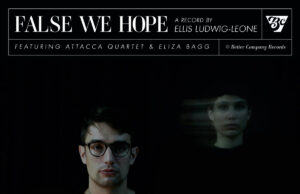
Off the Beaten Path: Ellis Ludwig-Leone’s “False We Hope”
Ellis Ludwig-Leone’s debut album where violence & serenity co-exist
By Chris RuelIn this installment of Off the Beaten Track, we look at “False We Hope” an experimental and innovative art song album that takes a new and jarring approach to the genre. Ellis Ludwig-Leone’s debut album explores themes of hope, loss, connection, and isolation. It features the Grammy-winning Attacca Quartet and soprano Eliza Bagg, with Ludwig-Leone on piano and synthesizer.
Ludwig-Leone’s composition style blends various textures that are both cinematic and minimalist. The album features a trio of voices, each sung by Bagg, and the strings of the Grammy-winning Attacca Quartet. The interplay between the voices, the strings, and piano is underpinned by a deep, eardrum-shaking synth bass. Ludwig-Leone collaborated with author Karen Russell and poet Carey McHugh for the text, and the cycle had its debut in 2022 at the Big Ears Festival.
The album’s 12 tracks offer variations on a theme of musical chaos, blending electronic and acoustic sounds to create a unique and intense soundscape that is both jarring and angular while also serene. Those two attributes don’t typically mesh, but Ludwig-Leone has taken these disparate characteristics and created something well off the beaten track.
The artists featured on “False We Hope” are the Grammy-winning Attacca Quartet, a highly versatile ensemble that is at home with 18th-century music as they are with contemporary, and soprano Eliza Bagg, a singer with solid experience in Renaissance, Baroque, and minimalist/post-minimalist singing styles. Bagg’s vocals are breathy and ghostly, with layered vocals that are mind-boggling. Meanwhile, the quartet uses aggressive plucks, snaps, bangs, intense bowing, and general musical mayhem in juxtaposition to Bagg’s vocal line.
Let’s take a brief look at each track of “False We Hope.”
1. False We Hope
The album’s opening track features a haunting “chorus” created by layering Bagg’s voice three times to create a virtual trio. The song has a cinematic vibe and a sense of forward motion, particularly the train-like clacking sound effects. Dissonant strings and melancholic cello are not musical, in the traditional sense; the musicality is found in the vocal line. “False We Hope” provides an uneasy warmth, combining the agitated strings with the warm sound blanket of Bagg unfolds.
2. Our Lady of the Dunes
The track begins with synth bass that vibrates your head, while Ludwig-Leone’s piano provides a sparse yet engaging melody on top. Bagg’s voice enters slowly, like a hushed conversation at the edge of hearing atop a thundercloud. The synth bass is more drone-like; however, it fluctuates, oscillates, and creates a sound reminiscent of being underwater.
The song’s text describes a woman who can be seen crossing a sandbar revealed by low tide, exposing a city of shells. The watery atmosphere of the music aligns perfectly with the text.
3. Prodigal Daughter
“Prodigal Daughter” is a haunting song that showcases the versatility of the Attacca Quartet, with its speed-metal-like bowing, along with powerful snaps and plucks that are absolutely manic. Bagg’s peaceful voice is a welcome contrast to the big crashes and aggressive bowing that make the song incredibly unsettling.
The cello and piano expressed melody or something close. Still, the song is pure chaos, with sound effects like a creaking floor adding to the atmosphere of loneliness and anxiety. The song’s ambiguous ending leaves the listener wanting more, as it feels like the music should continue rather than fade.
4. Speech I: Strong Consonants – String quartet
Ludwig-Leone uses Carey McHugh’s poem “Speech After the Removal of the Larynx” to create a world of consonant chaos. The bangs and snaps of the strings return, with swelling low strings pushing the music forward and rapid high strings mimicking the sound of a voice. The violent conversation between the strings leaves no toeholds, embracing dissonance and eschewing melody. The listener has no idea where the piece is headed, and though not too difficult on the ears, be prepared for a disconcerted piece.
5. A House, A Family
Driven by Bagg’s voice, this track features high strings crawling like bugs over the staves. The deep bass thumps like a heartbeat, providing a sense of life. Embedded within are various sounds, but their origin is hard to discern.
6. Unblessing
“Unblessing” starts with a cello and viola, with the cello’s smoothness contrasting with the viola’s more disorganized rhythm. At 01:43, bedlam erupts as the vocals and instruments meld together to create one massive, overpowering, and explosive sound. While some parts are less turbulent than others, the overall feeling is one of tension, not unlike the current state of the world, with its many unknowns and the troubling feeling that comes along for the ride.
7. Speech II: Sounds and their Captors
“Speech II: Sound and Captors” is a thrilling and messy (in the best possible way) instrumental track filled with jarring and abrupt sounds. The opening storm of vicious strings creates a sense of enclosure and inescapability for the listener. There is no melody whatsoever, and while instruments are used, the sounds produced are anything but musical. However, the cinematic jabs and riffs are exciting, not grating. Sharp-edged geometric sounds take over and leave the listener with a sense of directionless. The song’s wild and overwhelming aspects are bound to leave you feeling trapped in their grip.
8. How to Resurrect a Loved One’s Voice
One of the more rhythmically driven songs on the album is “How to Resurrect a Loved One’s Voice.” Synth-bass beats push the track forward like a lumbering giant’s footsteps. Bagg’s vocals are punctuated at first, perfectly following the earth-shaking rhythm, giving the song a powerful, almost chant-like feel. Again, we hear a train-like rhythm, this one like a passing subway, and the cut takes a surreal turn with spacey sounds from Ludwig-Leone’s synthesizer. Bagg’s vocals return with ethereal power, and the repeated line “Pray softer” adds a contrasting softness before the piece’s tempestuous tutti conclusion.
9. Welcome Home
“Welcome Home” is a quasi-lullaby-like track that envelops the listener with a sweet and soothing ambiance. The repeated phrase “welcome home” creates the feeling of a loved one being warmly welcomed. The song fits perfectly into the album’s wavelike structure, oscillating between peaceful and crashing moments. The song provides a moment of light and hope, with Bagg’s floating voice adding to the song’s more peaceful effect. By this point in “False We Hope,” the sense of calm provided by “Welcome Home” is greatly appreciated.
10 & 11. Speech III: Currents & Speech IV: Silence
Attacca creates a maniacal melding of sounds in “Speeches III: Currents” as the quartet’s instruments collide violently. While melody makes a brief appearance, the song has more to offer the listener with fascinating sound forms, such as the violin’s swan-diving gliss that zips by in the background. The track is musically diverse, venturing through assorted melodic and rhythmic themes. While we can find moments of tranquility, the track quickly transitions back into uncertainty, and there’s a hint of underlying anger.
“Speeches IV: Silence” is anything but and follows a similar tone and style to the previous Speeches. The tracks blend, making it difficult to distinguish whether you’re listening to a new song. Creepy-crawly strings that run and dive marked the piece, contributing to the song’s unsettling atmosphere. While more legato than “Speeches III,” the quartet still creates a stunning interplay of sounds, building upon the album’s musical and thematic coherence and showcasing the quartet’s talent for creating bizarre musical landscapes.
12. Litany
The final track of “False We Hope” ends quietly, featuring only piano and voice. The storm has passed, and the music calms.
Violence & Serenity
“False We Hope’s” experimental feel and jarring approach to art song offers a thought-provoking sonic journey across a strange and extraordinary soundscape that almost defies description. However, the unsettling intensity of Ludwig-Leone’s composition, Bagg’s ghostly vocals, and Attacca’s versatility make “False We Hope” a place where violence and serenity walk side-by-side.



